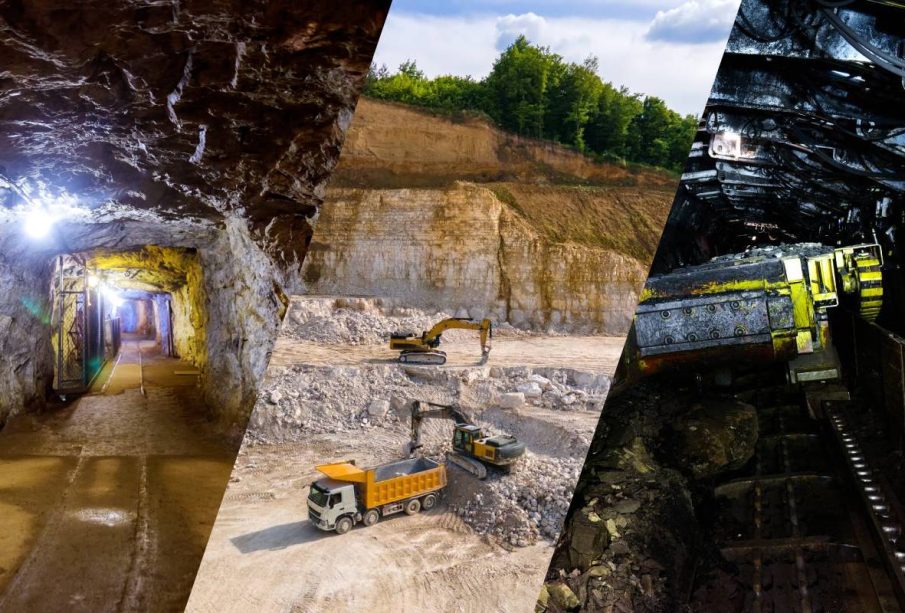
In our pursuit of valuable resources to power our modern world, we’ve been exploring and extracting non-stop. We’ve come up with innovative mining techniques to tap into rich deposits of minerals, ores, and precious metals found deep in the earth and even on the ocean floor.
These cutting-edge methods include open-pit mining, underground mining, and the exciting frontier of underwater mining. Each approach has its own unique opportunities, challenges, and impacts, shaping the landscape of resource extraction in the 21st century.
What is open-pit mining?
Open-pit mining is a surface mining technique used to extract minerals or other geological materials from the earth by removing them from an open pit or borrow. This method is commonly used for mining minerals such as coal, copper, gold, iron, and other valuable ores.
In open-pit mining, large quantities of overburden, the material lying over the mineral deposit, are removed to expose the desired resource. Heavy machinery, such as excavators, mini diggers, bulldozers, and dump trucks, are commonly used for excavation, removing the overburden and extracting the mineral ore. The extracted material is then processed to separate the desired minerals from the waste material.
Open-pit mining is often more cost-effective and efficient than underground mining, particularly for large-scale operations where the mineral deposit is close to the surface. However, it can have significant environmental impacts, such as habitat destruction, erosion, and contamination of soil and water resources. Efforts are made to mitigate these impacts through environmental regulations and reclamation processes.

What are the advantages of open-pit mining?
Open-pit mining offers several advantages:
- Cost-effectiveness: Open-pit mining is often more cost-effective than underground mining because it requires fewer labourers and equipment. The mechanized nature of open-pit mining allows for the extraction of large quantities of ore at a lower cost per ton.
- High production rates: Open-pit mining operations can achieve high production rates due to the use of large-scale equipment and machinery. This enables the extraction of large volumes of ore in a relatively short period, increasing overall productivity.
- Accessibility of deposits: Many mineral deposits suitable for open-pit mining are located near the surface, making them easily accessible. This accessibility reduces the need for extensive underground infrastructure and allows for quicker and more efficient extraction.
- Flexibility and scalability: Open-pit mining operations can be easily scaled up or down in response to changes in demand or market conditions. New mining areas can be opened, and production levels can be adjusted relatively quickly compared to underground mining operations.
- Safety: Open-pit mining generally poses fewer safety risks to miners compared to underground mining. The risk of cave-ins and other underground hazards is reduced, and the open nature of the pit provides better ventilation and visibility.
- Recovery of overburden materials: During open-pit mining, the overburden material removed to access the ore can often be utilized for other purposes, such as construction material or backfilling, reducing waste and maximizing resource utilization.
- Exploration opportunities: Open-pit mining exposes large areas of the earth’s crust, providing opportunities for geological exploration and discovery of additional mineral deposits in the vicinity.
While open-pit mining offers these advantages, it’s essential to acknowledge and address its environmental and social impacts, including habitat disruption, land degradation, and community displacement. Effective environmental management and mitigation measures are necessary to minimize these negative effects.
What is underground mining?
Underground mining, also known as subsurface mining, is a method of extracting minerals or other geological materials from beneath the earth’s surface. Unlike open-pit mining, which involves extracting minerals from an open pit or borrow, underground mining accesses mineral deposits that are buried deep underground.
There are various methods of underground mining, each suited to different geological conditions and types of mineral deposits. Some common underground mining methods include:
- Shaft mining: This method involves the creation of vertical shafts or tunnels to access mineral deposits below the surface. Miners and equipment are transported up and down the shafts to extract ore and transport it to the surface.
- Adit mining: Adits are horizontal or near-horizontal tunnels driven into the side of a hill or mountain to access mineral deposits. Adit mining is commonly used when the mineral deposit is located at a shallow depth and allows for easier access compared to shaft mining.
- Room and pillar mining: In this method, underground chambers, or “rooms,” are excavated, leaving behind pillars of ore to support the roof. The ore is extracted from the rooms, leaving the pillars intact. This method is often used in coal mining and some metal ore mining operations.
- Longwall mining: Longwall mining involves the use of a shearer, a cutting machine, to extract coal or ore in a long continuous panel. As the shearer advances, hydraulic supports are installed to prevent the roof from collapsing. Longwall mining allows for high extraction rates and is commonly used in coal mining.
- Sublevel caving: Sublevel caving is a method used for massive, low-grade ore bodies where ore is blasted and allowed to collapse under its weight. The broken ore is then collected through drawpoints located at the bottom of the cave. This method is suitable for large-scale operations with extensive ore bodies.
Underground mining can be more challenging and costly than open-pit mining due to the need for extensive infrastructure, ventilation, and safety precautions. However, it is often necessary to access deeper or more complex mineral deposits that cannot be economically mined through surface methods. Underground mining also tends to have fewer environmental impacts compared to open-pit mining, as it disturbs less surface area and mitigates habitat disruption.

While it’s a crucial method for accessing deep-seated deposits, underground mining poses various risks to miners, the environment, and surrounding communities.
Here are some of the key risks associated with underground mining:
- Safety hazards: Underground mining environments can be inherently hazardous due to the presence of confined spaces, poor ventilation, unstable geological conditions, and the operation of heavy machinery. Accidents such as rockfalls, collapses, fires, and explosions can occur, leading to injuries and fatalities.
- Health risks: Miners are exposed to various health hazards in underground mining, including exposure to dust, toxic gases, and chemicals. Respiratory diseases such as silicosis and coal workers’ pneumoconiosis (black lung disease) are common among miners. Additionally, exposure to diesel exhaust emissions and noise can cause long-term health issues.
- Geological hazards: Underground mining operations are susceptible to geological hazards such as rockbursts, seismic events, and subsidence. These hazards can result in structural damage to mine workings, equipment, and infrastructure, posing risks to personnel safety and disrupting operations.
- Water management: Underground mining can encounter challenges related to water management, including groundwater inflow, flooding, and the potential for contaminating groundwater sources with mining chemicals and waste. Effective dewatering and water treatment measures are essential to mitigate these risks and prevent environmental contamination.
- Environmental impacts: Underground mining can have significant environmental impacts, including habitat disruption, land subsidence, and contamination of soil, water, and air. The excavation of tunnels and shafts can alter natural drainage patterns and ecosystems, leading to habitat loss and fragmentation. Additionally, the release of pollutants from mining activities can degrade water quality and harm aquatic life.
- Social and community impacts: Underground mining operations can affect local communities through land acquisition, displacement of residents, and changes to traditional livelihoods. Noise, dust, and traffic associated with mining activities can also impact the quality of life for nearby residents. Effective community engagement and mitigation measures are essential to address these social impacts and promote sustainable development.
- Economic risks: Underground mining projects entail significant upfront capital investment and long lead times before production begins. Fluctuations in commodity prices, regulatory changes, and operational challenges can pose economic risks to mining companies, affecting project viability and profitability.
Addressing these risks requires comprehensive risk management strategies, including implementing stringent safety protocols, investing in advanced technology for monitoring and control, adopting sustainable mining practices, and engaging stakeholders in transparent communication and consultation processes.
What is underwater mining?
Underwater mining, also known as subsea mining or deep-sea mining, involves the extraction of minerals and resources from the seabed or ocean floor. This relatively new frontier in mining exploration targets valuable metals, minerals, and rare earth elements that are found in concentrations on the ocean floor. These resources may include polymetallic nodules, manganese crusts, seafloor massive sulfides, and hydrothermal vents.
Underwater mining operations typically utilize remotely operated vehicles (ROVs), autonomous underwater vehicles (AUVs), dredging equipment, and specialized mining machinery to extract and collect mineral deposits from the seabed. The extracted material is then brought to the surface for processing.
Some of the key resources targeted for underwater mining include:
- Polymetallic nodules: These potato-sized concretions contain high concentrations of metals such as nickel, copper, cobalt, and manganese. They are typically found in abyssal plains in the deep ocean.
- Manganese crusts: These crust-like deposits form on seamounts and other underwater features and contain high levels of manganese, as well as other valuable metals like cobalt, nickel, and rare earth elements.
- Seafloor massive sulfides: These mineral deposits are formed around hydrothermal vents on the ocean floor and contain high concentrations of copper, gold, silver, and other metals.
Underwater mining offers the potential for accessing valuable mineral resources that are inaccessible or economically unfeasible to extract through traditional land-based mining methods. However, it also presents significant technical, environmental, and regulatory challenges.

Challenges associated with underwater mining include:
- Technological complexity: Operating in the deep-sea environment poses technical challenges related to pressure, temperature, and navigation. Developing and deploying specialized equipment capable of withstanding these conditions is essential.
- Environmental impact: Underwater mining can disturb fragile ecosystems and habitats on the seabed, potentially affecting marine biodiversity and ecosystem functions. There are concerns about the long-term ecological consequences of large-scale mining activities in deep-sea environments.
- Regulatory framework: There is currently a lack of comprehensive international regulations governing underwater mining operations. Establishing effective regulatory frameworks to manage and mitigate the environmental and social impacts of underwater mining is essential for ensuring responsible resource extraction.
- Cost considerations: Underwater mining operations are inherently expensive due to the technical challenges and logistical requirements involved. Cost-effective extraction and processing methods need to be developed to make underwater mining economically viable.
Despite the challenges, people are getting more interested in underwater mining as we’re running out of metals and minerals on land and the demand for them is increasing. Research and development are working on tackling the technical, environmental, and regulatory challenges associated with underwater mining to unlock the potential of this emerging industry.
The bottom line
As we move forward into the future, we need to find essential resources to keep our journey going. We’ve come a long way from mining in open pits and deep tunnels, and now, we’re exploring the uncharted territories of the ocean floor. But, there are environmental, social, and technical challenges that we need to carefully consider and handle responsibly. We must strike a balance between meeting our present demands and preserving our planet for future generations. To do this, we need to innovate, collaborate, and commit to sustainability. By doing so, we can ensure that mining is a legacy of progress, prosperity, and preservation.
Latest Posts













